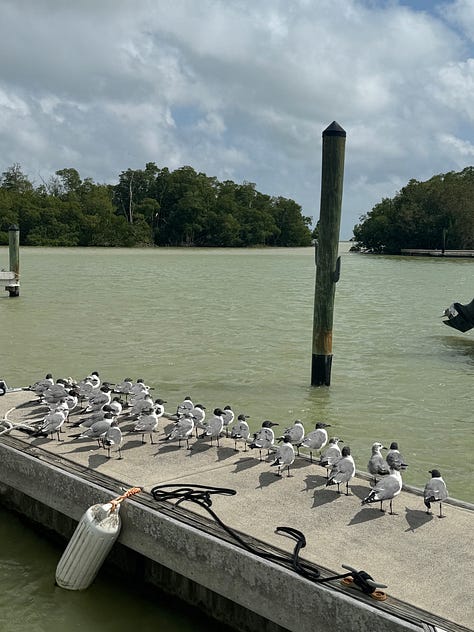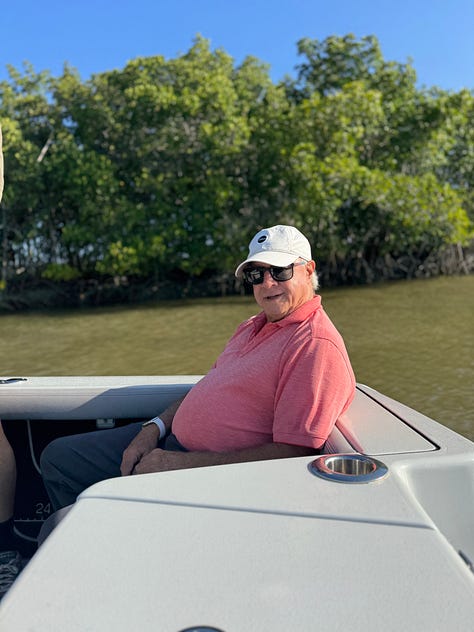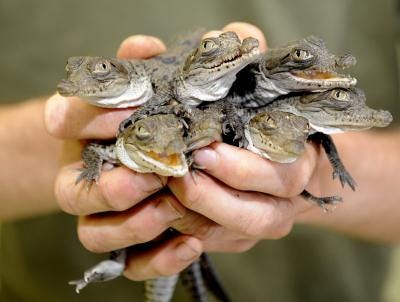Our Journey Into Wild, Crocodile Infested Waters
Just a stone's throw away from Miami lies a vast wilderness, the Everglades, where we met some of the most feared creatures on planet Earth
“There are no other Everglades in the world. They are, they have always been, one of the unique regions of the earth; remote, never wholly known. Nothing anywhere else is like them.”
— Marjory Stoneman Douglas
A week after our fishing trip to the Everglades was cancelled at the last second, setting up a chain of events that would help us discover “The Fishing Secret,” we decided to give it another shot. The following Saturday, on the ides of March, we got up well before dawn. We made egg salad and tuna salad sandwiches again under warm kitchen lights, listening to the signature sounds of the horny, invasive Tokay geckos who live in our roof.
Little did we know that we would be coming face to face with so many of their cousins in just a few short hours. We’re talking about a very different, much larger, native reptile. Yes, dear reader, our precious family would soon share the same waters with one of the world’s most ferocious predators, the American Crocodile. Crikey!
This morning, everything went like clockwork. Captain Nestor was ready to go. We transferred the kids while still asleep to the car and got moving while it was still dark. The transition from the sprawling metropolis of Miami to the Everglades, as night becomes day, is surreal. You pass Miami International Airport and keep heading southwest on the Palmetto Expressway. Eventually, the once formidable skyscrapers fade into the background, the fruit orchards of the Redlands come and go, and the next thing you know, you’re looking over this infinite expanse of grass and water with the moon setting and the sun rising in opposition.
The Everglades is the most immense wilderness in the United States east of the Mississippi River. It is an ecosystem rife with oxymorons, neither water nor solid land. The water is brackish but also sometimes salty or fresh. It’s not easy to survive in this territory, yet 39 native Florida species are threatened or endangered here, clinging to life in North America's largest subtropical wilderness.
Mirages abound here. Estuaries vanish and morph into a bay as the tide comes in. Red mangrove roots are bone dry, visible markers one instant. An hour later, the tidal waters submerge them, transforming them into bull shark nurseries and a labyrinth for fish to hide from crocodiles. This is also the largest mangrove forest in the Northern Hemisphere.
Arriving at dawn, you see none of this.
You must wait for the pink sun to kiss Miami Beach’s white sands, then Biscayne Bay and Miami until it finally reaches this massive watery marshland, illuminating and leaving a trail of color as we move towards the zenith of our daily trek. One can only admire this giant landscape painting being unravelled slowly and seductively as it reveals itself to you foot by foot. A great blue heron is already stalking an unsuspecting Florida gar for breakfast. A fish splash reverberates as a flock of ibises flies away in unison. The air is deceivingly crisp and cool, a trick that won’t last long as our fiery star warms up.
This is all happening just as Miamians begin their workdays by drinking their cortaditos, opening their computers, and checking out what’s happening with their 401k after another wild week in the stock market. Others are getting into their cars, running late to kid drop-off or the gym. Others are homeless. The frenetic activities of life begin in this parallel universe next door. The contrast between the Everglades and what we call civilization could not be more stark.
We made a short video of our day in the Everglades. This little 16X9 Instagram reel does not do it justice. The Everglades cannot be captured this way. No photographic aspect ratio that has existed or will ever exist can. Watch it anyway.
The late, great Florida journalist and conservationist Marjorie Stoneman Douglas, whose name is now randomly forever associated with a mass shooting in a public school named after her (And they call that “civilization”?), should be known for her efforts to conserve the Everglades. In her seminal 1947 book, Everglades: River of Grass. She wrote, “It reaches one hundred miles from Lake Okeechobee to the Gulf of Mexico, fifty, sixty, even seventy miles wide. No one has ever fought his way along its full length… There is no other river like it.” Douglas’s words transformed public perception of the Everglades from a useless swamp into a vital ecosystem worthy of protection. It is no coincidence that the same year she released her book, the Everglades became a National Park.
By 8 am, the sun was already high, hot, and bright in the sky. We loaded and then boarded our skiff in the famous Flamingo Marina. Captain Nestor jumped aboard, turned on the engines, and whisked us into the backcountry waters of the Everglades.
Today’s Everglades are far smaller than when Douglas wrote about them. They were 7 million acres back in 1947, but they have been drained so heavily for agriculture, development, and flood control that today they are only 2 million acres. It still feels immense, and one can only imagine what it was like back then. This maze of marshland, sawgrass, and mud is only accessible with a smaller boat, and ideally a captain familiar with the tides and terrain, as you are navigating very shallow waters where there can be little margin of error. Capt Nestor is one of the few captains who knows this place like the back of his hand.
We sped through mangrove-lined, winding creeks, twisting and turning through this aquatic labyrinth until we got to our destination, a little shaded spot where the red mangroves grow high and dense over this wide estuary jutting out from the Florida Bay. We noticed something as we were running. At almost every riverbank, a crocodile seemed to be basking or sliding into the water as we passed it. We knew from prior trips that this was a possibility. However, in the past, if we were lucky, we saw one or two. This time, we saw dozens of American crocodiles in just a 15-minute boat ride. The waters here were infested with them.
This is the only place on Earth where alligators and crocodiles live together. However, crocodiles are saltwater tolerant compared to alligators and tend to inhabit those areas to avoid competition with alligators, which outnumber crocodiles by almost 200X. There are about 200,000 alligators in the Everglades, but only about 1,000 crocodiles. We’re used to seeing gators, especially in the more inland areas, but not too many crocs.
We couldn’t believe how many crocodiles we were seeing. Some of them were so well camouflaged on the shore that none of us noticed them until we saw them slide into the water. Once they slid down, they would disappear into the brackish, muddy water below. We reminded the kids to be careful fishing from the boat's edge so they would not accidentally fall in.
What’s crazy is that in the early 1970s, the American crocodile (Crocodylus acutus) was on the verge of extinction in the United States. Only about 300 individuals and fewer than 20 nests remained in South Florida, the only place in the country with a native population of American crocodiles. If it weren’t for the Endangered Species Act, passed in 1973, and the species listing as endangered in 1975, which prohibited hunting and limited habitat destruction, there likely would be no American crocodiles left in the wild in the USA.
The genus Crocodylus, which includes the American crocodile (Crocodylus acutus), likely originated in Africa and began diversifying around 25 million years ago. This means that crocodiles as a group have existed since the time of the dinosaurs! How could humans let this apex predator dwindle to the point of extinction now, mainly due to our behavior? The effects of it would ripple through the entire ecosystem, affecting every animal and plant in the habitat. Can you imagine letting one of the oldest living reptiles on Earth go extinct on our watch?

Thankfully, federal regulations kicked in at the last minute, forcing an unlikely partnership of conservationists, government agencies, and the utility company Florida Power and Light (FPL) to establish sanctuaries for crocodiles in Everglades National Park, Biscayne National Park, Crocodile Lakes National Wildlife Refuge, and the cooling canals of the Turkey Point Nuclear Power Plant just south of Miami.
Yes, you read that right. Crocodile nests were discovered in the nuclear energy facility, operated by FPL, in 1977. A monitoring program began, and today, around 25% of the U.S. crocodile population now resides in this managed habitat, which offers safety from human disturbance and predators. Think of it as an outdoor, semi-wild, real-life, Florida version of Jurassic Park, where the threat of nuclear disaster and man-eating reptiles converge next to one of the largest metropolises in the United States. What could go wrong?

Internationally, the American crocodile is listed as vulnerable on the IUCN Red List, with an estimated 20,000 left in the wild, despite being the most widespread crocodile species in the Americas. It is native to most of the tropics. It has significant populations in Cuba, Jamaica, and Hispaniola in the Western Caribbean, throughout Central America on Pacific and Atlantic coasts, and even down to northern Peru and Ecuador in South America.
Despite protections under CITES Appendix I in most of its range restricting international trade, illegal hunting and poaching continue to wipe out the species in certain countries, like Jamaica and Belize, where they are critically endangered. In other countries, like Costa Rica, Cuba, Mexico, and Venezuela, populations have recovered due to conservation measures. So, as you can see, it’s a mixed bag. And the poorer and more lawless the country, the more incentives there are to turn a wild, living crocodile into a leather purse or belt or a meal to feed your village.
Fortunately for us that day in the Everglades, we had plenty of fish. We caught plenty of snook, redfish, and sea trout. Dana hooked a pretty big tarpon, but it managed to wriggle free. The kids loved every second of it, smiling from ear to ear with their catches of the day. It’s nice to see that despite the resurgence of the crocodiles, there are plenty of fish to go around. We took home what we could eat, and threw the rest of them back. We cleaned them and prepared the filets right on the spot.









Finally, it was time to go home. We drove out of this wild land, the Everglades, and soon saw the city's lights. It was reassuring to be the apex predator again. And even more reassuring to know that the apex predator of the Everglades was in the process of restoring its former glory. And just like that, this seemingly infinite expanse of life, where crocodiles lurk below the water line, vanished in the rearview mirror, transforming into a sacred, lifelong memory.
Check out Dana’s latest art print featuring the American crocodile, “Crocodilian Fantasy.” Buy one for your home or office!
A portion of the proceeds from this one will go to The Crocodile Foundation, a US-based 501(c)(3) non-profit organization dedicated to the protection and preservation of wild crocodilians worldwide, with a mission focused on ensuring safe coexistence between crocodiles and humans. They operate primarily through volunteer outreach programs in rural communities of developing nations, especially in East Africa and Indonesia, where human-crocodile conflicts are high. Their efforts center on education, safety measures, and direct assistance to reduce conflicts and promote understanding crocodiles’ vital ecological roles.
Key activities of The Crocodile Foundation include:
Education: Providing outreach and awareness programs to villagers, government institutions, and local wildlife services to dispel misconceptions about crocodiles and teach safety protocols that help prevent attacks and conflicts. They distribute free educational materials in multiple languages, emphasizing that many crocodile attacks are avoidable through proper knowledge and precautions.
Assistance: When necessary, they humanely translocate problem crocodiles away from human settlements, using GPS tracking to monitor their movements post-release. This is done with careful planning to ensure the safety of both people and crocodiles and to maintain ecological balance.
Research: The foundation studies crocodilian behavior, including movement patterns, home ranges, and responses to conditioning before translocations. This research helps improve conservation strategies and safe coexistence practices.
US Programs: While its primary focus is on developing nations, the Crocodile Foundation also supports conservation and education efforts for American crocodiles and alligators in the United States, particularly in South Florida.
Overall, the Crocodile Foundation is vital in mitigating human-crocodile conflicts through education, humane management, and scientific research. It helps to protect crocodiles while ensuring community safety and fostering coexistence.
Finally, as promised, here’s a video of wild crocodile vs. alligator interactions filmed in the Everglades! #onlyindade











I love this illustration! ❤️